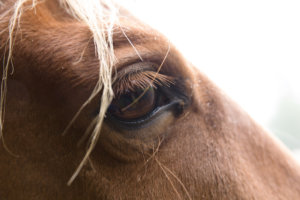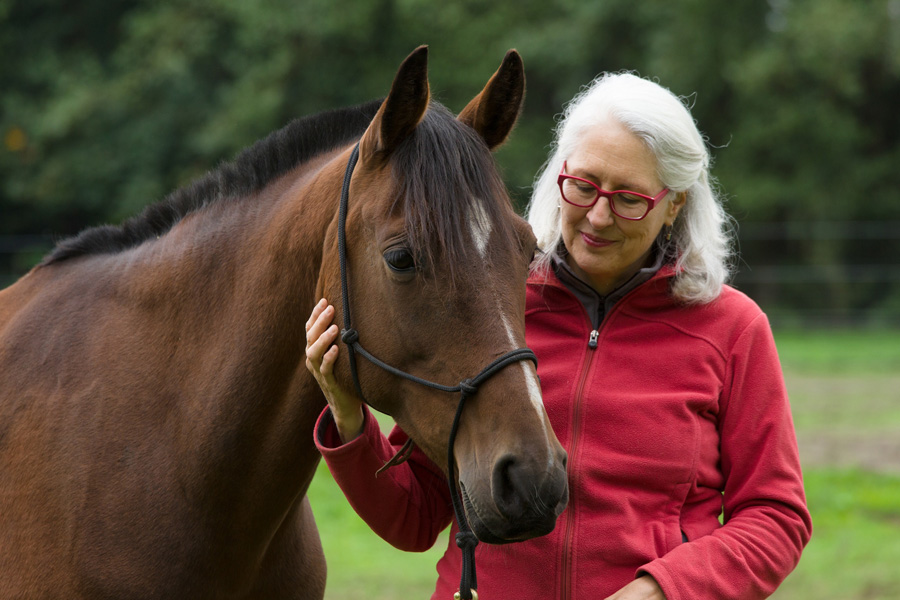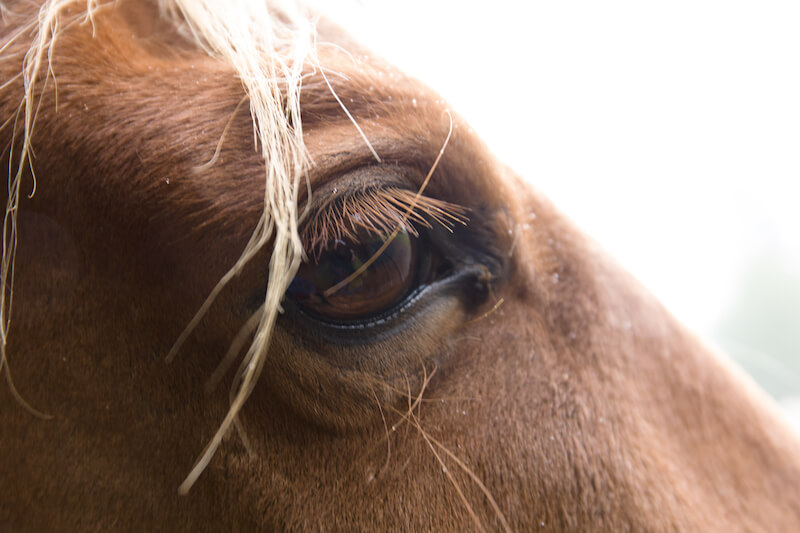Understanding Equine Vision
by Barbara Breckenfeld
A horse suddenly goes from relaxed to total alert, head high, ears pricked. We look, we wonder what the horse sees, but often we can only guess.
It is easy to assume that horses see the same way we do, but they really don’t. A closer look at equine vision provides insights into living and working with horses, especially when their behavior befuddles.

Horses’ eyes are largest of any land mammal (twice the size of human eyes) and have more long-distance acuity than most other mammals. Evolving on the open plains, they can see into the distance while running up to 40 miles per hour. They see about 2/3 as clearly as we do.
Horses have both binocular and monocular vision. Monocular means each eye sees independently, and that’s why horses need to look at things from both sides. Each eye sees to the front, side, and rear with 130-140º of vision for a combined range of 260-280º.
To use binocular vision effectively, a horse must move their head and neck freely. Grazing horses see nearly 360º by rotating their heads, the view behind only blocked by their lower legs. Such an elegant adaptation!
Binocular vision enables depth perception using both eyes to perceive an image that the brain combines into a single 3D view. With eyes in the front of our heads, people have 100% binocular vision. With eyes protruding from the sides of their head, horses’ binocular vision gives them 75-95º of focus directly in front of them.
Horses don’t see the color red, similar to someone with red-green color blindness. Limited color perception means they see fewer details. A red object, obvious to us on green grass, may not be noticeable to a horse who doesn’t see the contrasting color. The horse may not detect the object until close enough to see it with binocular vision. Horses distinguish about 10,000 different colors while humans perceive millions.
Horses see wide, flat, and narrow while our visual field is circular. Their pupil shape gives a wider horizontal view of nearly 360º without turning their head. Grazing horses can see close up things clearly: what they are eating, in front of their feet. With raised head, they see and perceive potential threats at great distance.
Human eyes adapt to changes in light levels quickly, while horses’ may take 30 minutes. Once adjusted, horses are much better than people at detecting small movements in low light. It’s one of their survival superpowers. Their eyes also send messages to their central nervous systems much faster than human eyes. Things to consider when leading a horse into a new barn or loading into a dark trailer from bright sunshine.
Working with Equine Vision
Horses’ vision evolved to help them survive. Problems can stem from injury, disease, or be hereditary, and almost always warrant an emergency vet call.
Horse nature says, “Better safe than sorry.” Horses don’t like novelty and are wired to react to it. They need to examine something new in order to understand it. And they need to do it from both eyes. Yet, once they have looked closely at something, they usually stop being concerned.
Allowing horses to experience new things in familiar areas reduces the amount of novelty they experience. We can also accustom horses to objects moving in and out of different fields of vision, from monocular to binocular, side to front.
Horses use the position of their head and neck to maximize what they see, naturally raising their head approaching a jump, or lowering their head to find footing over uncertain ground. Riding a horse with an over bent neck limits vision to feet only. If their vision is limited, they may shy, bolt, or refuse to move.
Understanding a horse’s vision, including blind spots—directly behind the tail, directly in front of the forehead, along the center of the back (especially withers), and with raised head, directly under the head and nose—helps us know when to allow them time to look and explore things they aren’t sure about.
Sometimes when a horse seems to be misbehaving, it may be having trouble seeing. Understanding our horses’ vision gives us more ways to partner with them as we hang out, ride, train, and adventure with them.

Barbara Breckenfeld of Movement in Balance does equine bodywork/massage and healing in the greater Puget Sound area, as well as offering her popular “Bodywork for Horses” clinics. She is nationally certified by NBCAAM, licensed as a Large Animal Massage Practitioner (LAMP) in Washington State, and an Equine Structural Integration Practitioner certified by the Equine Natural Movement School. Barbara became a horsewoman in 1993 when a handsome dapple-gray won her heart and introduced her to the fundamentals of dressage. Contact Barbara by email [email protected], call 425-260-0784, or visitwww.movementinbalance.com.






